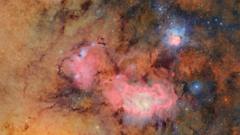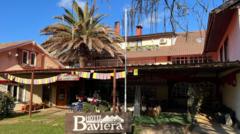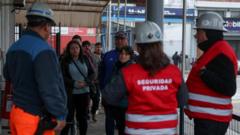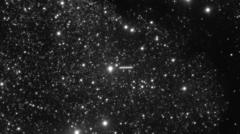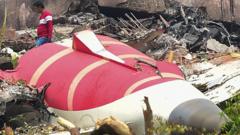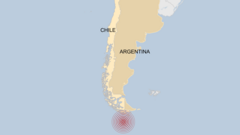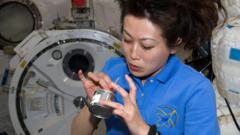The Vera Rubin Observatory in Chile has made headlines by unveiling its first exquisite images of the Trifid and Lagoon nebulae, showcasing the telescope's remarkable capabilities to probe the distant reaches of the universe. Located high in the Andes, this observatory features the world's most powerful digital camera, heralding a new era of astronomical discovery.
With its ability to capture breathtaking images of gas and dust clouds in star-forming regions, the telescope promises to revolutionize our understanding of cosmic structures. Scientists believe that if any ninth planet exists in our solar system, the Rubin observatory could discover it within its initial year of operation. Additionally, it aims to identify hazardous asteroids, map our Milky Way galaxy, and provide insights into the elusive nature of dark matter.
Professor Catherine Heymans, the Astronomer Royal for Scotland, expressed excitement about this pivotal moment in the field of astronomy, marking the culmination of decades of effort to bring this facility to fruition. The UK plays a pivotal role in the project as a key partner, with dedicated data centers to process the wealth of detailed images the telescope will generate over the next ten years.
The observatory is strategically located on Cerro Pachón, recognized for its high altitude, minimal humidity, and dark skies—ideal conditions for celestial observation. Those involved ensure that the dark atmosphere is maintained, as any stray light can interfere with the telescope's sensitive imaging capabilities.
Equipped with a 3,200-megapixel camera designed by the SLAC National Accelerator Laboratory, the telescope can capture a wealth of light, essential for studying distant and faint cosmic phenomena. Its innovative three-mirror design enables detailed imaging, while its capability to systematically survey the same sky regions repeatedly will allow scientists to detect changes and transient cosmic events with unprecedented frequency.
The anticipated data flood will shatter previous records, with projections suggesting up to 10 million alerts per night to monitor celestial transients, Milky Way formation, solar system mapping, and dark matter investigations. Professor Alis Deason from Durham University emphasizes that the forthcoming dataset will provide unmatched insight into the galaxy.
Vera Rubin’s expansive reach could finally shed light on longstanding mysteries, such as the hypothesized Planet Nine. Its ability to explore regions far beyond the scope of current ground-based telescopes represents a breakthrough in our astronomical capabilities.
As scientists prepare to analyze the continuous streams of data, excitement builds within the community about the transformative potential of the Vera Rubin Observatory—a testament to human ingenuity and dedication to unveiling the mysteries of the cosmos.
With its ability to capture breathtaking images of gas and dust clouds in star-forming regions, the telescope promises to revolutionize our understanding of cosmic structures. Scientists believe that if any ninth planet exists in our solar system, the Rubin observatory could discover it within its initial year of operation. Additionally, it aims to identify hazardous asteroids, map our Milky Way galaxy, and provide insights into the elusive nature of dark matter.
Professor Catherine Heymans, the Astronomer Royal for Scotland, expressed excitement about this pivotal moment in the field of astronomy, marking the culmination of decades of effort to bring this facility to fruition. The UK plays a pivotal role in the project as a key partner, with dedicated data centers to process the wealth of detailed images the telescope will generate over the next ten years.
The observatory is strategically located on Cerro Pachón, recognized for its high altitude, minimal humidity, and dark skies—ideal conditions for celestial observation. Those involved ensure that the dark atmosphere is maintained, as any stray light can interfere with the telescope's sensitive imaging capabilities.
Equipped with a 3,200-megapixel camera designed by the SLAC National Accelerator Laboratory, the telescope can capture a wealth of light, essential for studying distant and faint cosmic phenomena. Its innovative three-mirror design enables detailed imaging, while its capability to systematically survey the same sky regions repeatedly will allow scientists to detect changes and transient cosmic events with unprecedented frequency.
The anticipated data flood will shatter previous records, with projections suggesting up to 10 million alerts per night to monitor celestial transients, Milky Way formation, solar system mapping, and dark matter investigations. Professor Alis Deason from Durham University emphasizes that the forthcoming dataset will provide unmatched insight into the galaxy.
Vera Rubin’s expansive reach could finally shed light on longstanding mysteries, such as the hypothesized Planet Nine. Its ability to explore regions far beyond the scope of current ground-based telescopes represents a breakthrough in our astronomical capabilities.
As scientists prepare to analyze the continuous streams of data, excitement builds within the community about the transformative potential of the Vera Rubin Observatory—a testament to human ingenuity and dedication to unveiling the mysteries of the cosmos.

